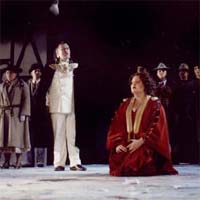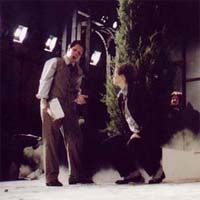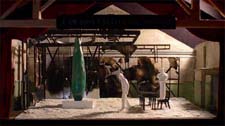La Clemenza di Tito
Wolf Trap Opera Company
June 2003
 Approaching Mozart's final composed opera (Magic Flute would premiere after Tito, but Flute was finished before Mozart traveled to Prague), we realized the recits and the arias often tell the same story. This allowed us to pare down the piece to white-hot essentials (not unlike trimming a long Shakespeare play) and let the story unfold with the musical numbers. We also wanted to find a period and style that was more current than Ancient Rome. The Edwardian era suited us well — both in making Vitellia the flame that draws men to her, and in providing the formality for Tito and Sesto as they struggle to find peace and forgiveness after betrayal and tragedy.
Approaching Mozart's final composed opera (Magic Flute would premiere after Tito, but Flute was finished before Mozart traveled to Prague), we realized the recits and the arias often tell the same story. This allowed us to pare down the piece to white-hot essentials (not unlike trimming a long Shakespeare play) and let the story unfold with the musical numbers. We also wanted to find a period and style that was more current than Ancient Rome. The Edwardian era suited us well — both in making Vitellia the flame that draws men to her, and in providing the formality for Tito and Sesto as they struggle to find peace and forgiveness after betrayal and tragedy.
 Luke Cantarella inspired us with looking for that "moment of beauty" within the work, and it was Vitella's final aria where she decides to own up to her guilt and try to save Sesto from execution. This aria seemed to be the leaping off point for Mozart's score — and it became the ray of sunshine in our production as well. We chose to show the "pristine world" of Tito's Rome burned and destroyed, revealing the ordinary outside surround behind the facade and putting the evidence of the crime (burning down the Roman Senate) directly in front of us for Act II. We're also on the bridge to the Romantic era which other composers would take up after Mozart, so the sense of something unfinished, leading towards an unknown future was also appealing in the design.
Luke Cantarella inspired us with looking for that "moment of beauty" within the work, and it was Vitella's final aria where she decides to own up to her guilt and try to save Sesto from execution. This aria seemed to be the leaping off point for Mozart's score — and it became the ray of sunshine in our production as well. We chose to show the "pristine world" of Tito's Rome burned and destroyed, revealing the ordinary outside surround behind the facade and putting the evidence of the crime (burning down the Roman Senate) directly in front of us for Act II. We're also on the bridge to the Romantic era which other composers would take up after Mozart, so the sense of something unfinished, leading towards an unknown future was also appealing in the design.
GARNETT
Photographs courtesy of Luke Cantarella

